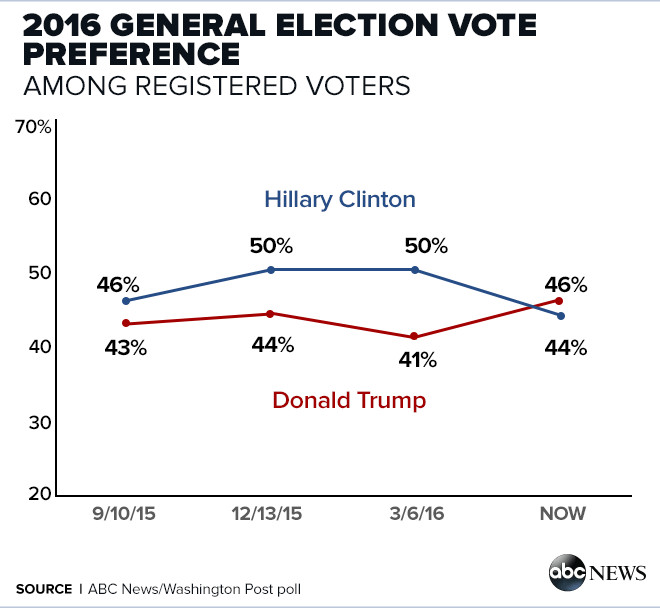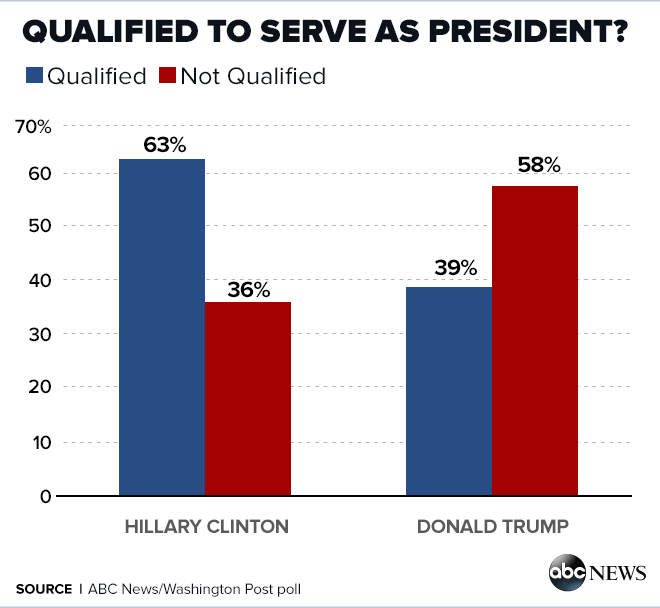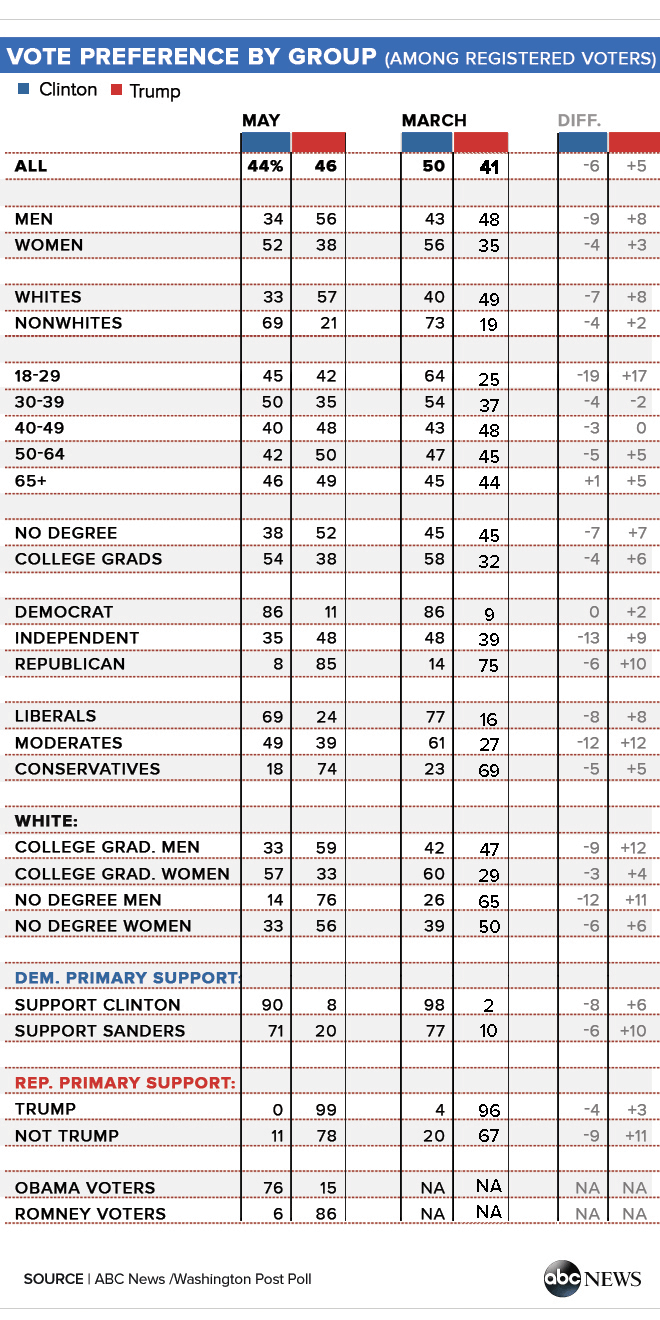A Post-Primary Rally Boosts Trump, Albeit With Challenges Aplenty (POLL)
A new ABC News/Washington Post poll shows a close presidential contest.
— -- A new ABC News/Washington Post poll shows a close contest in presidential election preferences, with Republicans lining up behind Donald Trump as their party’s presumptive nominee while the continued Democratic race is keeping Hillary Clinton’s side more unsettled.
Greater voter registration among Republicans is one factor: Clinton’s 6-point lead among all adults, 48-42 percent in a general election matchup, switches to essentially a dead heat among registered voters, 46 percent for Trump, 44 percent for Clinton. Regardless, the contest has tightened considerably since March, when Clinton led among registered voters by 9 points.
See PDF with full results here.

Trump’s enhanced competitiveness reflects consolidation in his support since his primary opponents dropped out, and it comes despite significant challenges to his candidacy. Fifty-eight percent of Americans call him unqualified to be president, 60 percent see him unfavorably overall, 76 percent think he doesn’t show enough respect for those he disagrees with and 64 percent say he should release his tax returns (with most feeling strongly about it). These include majorities of registered voters on each item, representing opportunities for Clinton.
Republicans and Republican-leaning independents, moreover, split 46-46 percent on whether or not Trump represents the core values of the party. That’s sharply improved from 29-56 percent in July, but it leaves the party still divided on a key measure of Trump’s suitability.
Clinton has challenges of her own –- 53 percent of Americans (and 57 percent of registered voters) see her unfavorably, making this a matchup between the two most unpopular likely presidential candidates in the history of ABC/Post election polls, dating back to 1984.

Indeed, half of each candidate’s supporters are negative voters, saying they oppose the other candidate more than they support their own choice. Fewer than half on either side back their candidate strongly. And while 51 percent of Americans say they’d be satisfied with a Clinton-Trump race, 44 percent say they’d want a third-party candidate to run.
Most potential voters, though, seem committed in opposition, if not in support. Marking the level of cross-party antipathy in this contest, 86 percent of Trump supporters say they’d never consider voting for Clinton –- and 86 percent of Clinton supporters say the same about Trump.
The continued Democratic primary race appears to be sapping some of Clinton’s strength in this poll, produced for ABC by Langer Research Associates. She’s losing 20 percent of Bernie Sanders’ supporters to Trump, while winning only 11 percent of leaned Republicans who backed someone other than Trump for their party’s nomination.
Remarkably, Clinton is only running evenly with Trump among 18- to 29-year-olds –- a key Sanders support group that’s looking ever-more resistant to her nomination. In March, Clinton led Trump among under-30s by 39 percentage points, 64-25 percent. Today they split 45-42 percent. It’s a group Barack Obama won by 23 points in 2012, and one that Clinton needs back.
That said, Clinton has some powerful cards in the hole, particularly if she can bring her party together and mobilize her key support groups. She continues to lead in expectations that she’ll win, albeit more narrowly than previously. In the primaries, 56 percent of leaned Democrats support her for the nomination, +7 from March, while just 33 percent of leaned Republicans say they preferred Trump. And 55 percent of leaned Democrats are “very confident” the party will coalesce around its nominee, double the share of leaned Republicans who strongly expect Kumbaya to prevail in their party.

Clinton’s better positioned in other ways as well. In sharp contrast to Trump, 63 percent of Americans see her as qualified to be president. She leads him by substantial margins on several key attributes, including experience, personality and temperament and having realistic policy proposals. She leads him widely on several issues as well, including handling international relations, looking out for the middle class and dealing with concerns of prime interest to women.

Trump has no leads on attributes or issues of the magnitude of Clinton’s (save on taxes, among registered voters). But there are several – including crucial ones – on which he’s competitive. On attributes, these include honesty and trustworthiness, being the stronger leader and making the country safer and more secure. On issues, beyond taxes, they include handling the economy, terrorism and international trade.
Results are similar among all adults and registered voters alike, albeit slightly better for Trump among registereds:

Beyond issues and attributes, two external factors ultimately may assist Clinton: Barack Obama’s holding steady at bare majority approval, 51 percent, in this survey. And Americans see the Republican Party unfavorably by a 20-point margin, 36-56 percent, favorable-unfavorable. The Democratic Party, while hardly popular, does much better, 48-44 percent.
That said, Clinton’s immediate challenge is that she’s still facing a popular primary opponent, Fifty-one percent of Americans overall see Sanders favorably, 7 points better than Clinton (and +14 vs. Trump). If she clinches the nomination as anticipated, Sanders’ willingness to patch things up may be critical.
Trends
The gap between Clinton and Trump on some issues has narrowed considerably, another sign of Trump’s consolidation as he’s apparently sewn up the nomination. In March she led him by 14 points among all adults in trust to handle terrorism; it’s a non-significant 3-point gap today. Her lead on trust to handle immigration has moved from 19 points to 9; and on trust to handle an international crisis, from 29 points to 19.
Further, Americans in March by 62-34 percent said they wanted someone with political experience, rather than an outsider, for president. Today that’s narrowed to 52-43 percent, and among registered voters it’s an essentially even 48-47 percent split. Trump, of course, has presented himself as the quintessential outsider candidate.
Tightening has occurred in expectations, as well. Americans by 50-40 percent say they expect Clinton to win vs. Trump. That’s closed from 59-36 percent in March, but remains a continued advantage for her. (She leads similarly on this measure among registered voters.)
Groups
Support groups –- and changes among groups –- are highly revealing. Trump now leads Clinton by 22 points among men; he was +5 among men in March. Clinton’s +14 vs. Trump among women (it was +21 two months ago.) The current 36-point gender gap is vast – double the average in presidential election exit polls since 1996.
Trump, further, now has a 24-point lead over Clinton among whites who are registered to vote, up from 9 points in March. Clinton’s backed by seven in 10 racial and ethnic minorities, the single most critical Democratic support group. (Obama lost whites by 20 points in 2012, yet won re-election in an electoral college landslide.)
The shift among young voters, noted above, is especially striking. Another result indicating Sanders-related defections is the number of liberals saying they’d support Trump vs. Clinton – now 24 percent, up 8 points from March. (Eighteen percent of conservatives say they’d back Clinton, down a non-significant 5 points.) And Trump leads Clinton among independents by 13 points, a reversal from March, when she led by 9.
In one further example of the unsettled Democratic contest, 15 percent of Obama voters in 2012 now say they’d back Trump over Clinton. Just 6 percent of Mitt Romney’s supporters say they’d take Clinton over Trump.

A key breakdown among whites is by education. Working-class white men – i.e., those who lack a four-year-college degree – favor Trump by an overwhelming 76-14 percent. That shrinks to still-substantial Trump advantages of 36 points among college educated white men and 33 points among non-college white women. By contrast, college-educated white women currently back Clinton by 24 points, 57-33 percent. Obama lost that group by 6 points.
Three Issues
Beyond his outsider status, Trump rode three issues to dominance in the GOP primaries: Deporting undocumented immigrants, temporarily banning non-citizen Muslims from entering the country and (unusually for a Republican) opposing free trade agreements. Two of these sharply divide the country; the third, trade, is a winner for Trump and risk to Clinton.
Americans in this survey oppose deporting all undocumented immigrants and oppose barring Muslims from entry, albeit just by single-digit margins, 50-44 and 50-43 percent, respectively. (These go to essentially an even split among registered voters.) International trade, though, is another matter: The public by 53-33 percent thinks trade kills rather than creates U.S. jobs. And Trump leads Clinton by 18 points, 55-37 percent, among anti-trade voters. It’s an economic issue on which he’s got a clear advantage.

More
Among other results in the survey:
House vote. Trump appears to pose a bit more risk to Republican House candidates than Clinton to Democrats. Thirty-four percent of registered voters say they’d be less likely to support a candidate for Congress who backed Trump, vs. 20 percent more likely – a 14-point net negative impact. By contrast, 30 percent would be less likely to support a Clinton backer, 24 percent more likely, a net of -6. As things stand, registered voters divide evenly, 45-45 percent, on whether they’d support the Democrat or Republican in their district if the election were today.
3rd party. As noted, 44 percent back the idea of a third-party candidate. Testing Mitt Romney (who’s ruled it out) doesn’t produce much of a shakeup, leaving Clinton +2 vs. Trump among registered voters, vs. Trump’s +2 without Romney – differences that are within polling tolerances. Romney draws 24 percent of Trump’s supporters, and 16 percent of Clinton’s.
Help whom? Americans by a wide margin think Trump would do more than Clinton to help the wealthy, while by closer margins think Clinton would do more for working- and middle-class Americans. The divisions are very similar to what they were for Obama and Romney in 2012, suggesting another vulnerability for Trump that Clinton may seek to exploit.
Woman card? Finally, this poll finds a split decision on gender politics: The public divides on whether being a woman helps Clinton more (32 percent say so), or whether being a man helps Trump more (29 percent). (Generally, Clinton supporters tend to say Trump gets the gender advantage, while Trump supporters tend to say Clinton does.) In either case, those who see an advantage are more apt to see it as unjustified than as justified.
Methodology
This ABC News/Washington Post poll was conducted by landline and cellular telephone May 16-19, 2016, in English and Spanish, among a random national sample of 1,005 adults, including 829 registered voters. Results have a margin of sampling error of 3.5 points, including the design effect, for the full sample and registered voters alike. Partisan divisions are 33-25-35 percent, Democrats-Republicans-independents, in the full sample, 34-27-33 among registered voters.
The survey was produced for ABC News by Langer Research Associates of New York, N.Y., with sampling, data collection and tabulation by Abt-SRBI of New York, N.Y. See details on the survey’s methodology here.